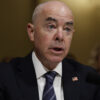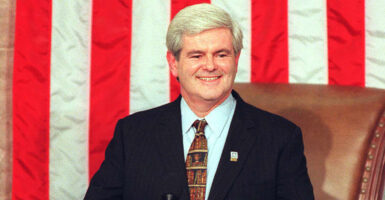Rep. Kevin McCarthy’s tough climb to the speakership seems rare in the modern era, but brawls over the top House job are not uncommon historically.
After voters decided which party would control the House, the elected lawmakers battled in 14 instances when electing a speaker required multiple ballots.
But it was a century ago—1923—when a speaker’s race last went to multiple ballots.
Notably in decades past, after congressional races in November, a new Congress wasn’t sworn in until March of the next year—and often it wouldn’t convene until December of the next year. For example, after the 1922 midterm elections, the vote for House speaker came in December 1923.
After McCarthy failed to reach the needed 218 votes for speaker in three ballots Tuesday and three more Wednesday, the House adjourned until 8 p.m.
Even when there weren’t multiple ballots, past contests for speaker have included drama.
Here’s a look at some of the most dramatic and contentious races for House speaker.
1. ‘Never Nancy’ Democrats
Democrats won control of the House in the 2018 midterm elections, but 21 of the newly elected and returning Democrats vowed during the campaign that they would not vote for House Democrat Leader Nancy Pelosi, D-Calif., to reclaim the speakership.
Of those 21 Democrats, 13 were freshmen; another previously had won a special election in Pennsylvania. They were a mix of far-left progressives in deep-blue congressional districts, where Pelosi was viewed as an out-of-touch Washington hand, and moderates who ran in red and purple districts who didn’t like her politics.
Another 19 successful Democrat candidates in the 2018 midterm elections were noncommittal during their campaigns about whether they would vote for Pelosi to return as House speaker in January 2019 after her stint in the job from 2007 to 2011.
Initially, Democrats’ goal was to allow these new members to keep their promise by opposing Pelosi for speaker in a meeting of the House Democratic Caucus, but support her in the House floor vote. However, 16 Democrats formalized their opposition by signing a letter asserting that they were “committed to voting for new leadership in both our caucus meeting and on the House floor.”
Eventually, Pelosi was forced to negotiate a deal with these Democrats, agreeing that she and her leadership team of Reps. Steny Hoyer, D-Md., and James Clyburn, D-S.C., would term-limit themselves to four years.
This convinced most of the rebellious Democrats to return to the fold. On Jan. 3, 2019, the opening day of the session, just 12 Democrats voted for someone other than Pelosi for speaker while three abstained.
Pelosi still had enough support, 220 votes, to become speaker again.
2. Reelecting Gingrich
After the 1994 election, new House Speaker Newt Gingrich of Georgia became a historic figure as the first Republican speaker in four decades.
However, during his first term as speaker, Gingrich came under investigation for giving the House Ethics Committee inaccurate information about a televised college course that he taught. He was scrutinized for not seeking advice about the legality of the financing for the course. Gingrich apologized over the matter.
After the 1996 elections, the GOP again held the majority in the House. The leadership election was scheduled for Jan. 8, 1997. After significant media buildup, Gingrich lost only nine Republicans.
Four House Republicans voted against Gingrich. Two voted for Rep. James Leach of Iowa, another voted for former Minority Leader Robert H. Michel of Illinois, and one voted for then-Rep. Bob Walker of Pennsylvania.
Meanwhile, five other Republicans abstained. Gingrich was elected speaker again with 216 votes.
To be elected speaker, someone must win an absolute majority of the votes cast. That’s not the same as winning the majority of votes of the full House. When Gingrich regained the speakership, one House Republican’s plane was late and two House Democrats were hospitalized, according to The New York Times.
3. A Record 133 Ballots
It’s perhaps not unusual that the most contentious House speaker’s race in history happened just five years before the nation was ripped apart by a bloody Civil War.
Factionalism was a major problem in December 1855, when 21 House members initially ran for speaker. Issues dividing the country were both slavery and immigration; the American Party, also known as the Anti-Mason or “Know Nothing” party, had elected members to the House, as had the antislavery Free Soil Party.
The Republican Party, founded the year before, was still in its infancy.
The House continued voting for about two months and cast 133 ballots before settling on Rep. Nathaniel Banks of Massachusetts, a member of both the American Party and the Free Soil Party. Banks won 103 votes and Rep. William Aiken, D-S.C., won 100.
4. Replacing Henry Clay
Rep. John W. Taylor of New York was a member of the National Republican Party, an anti-Jacksonian party in the early 1800s associated with House Speaker Henry Clay and former President (and later House member) John Quincy Adams.
In October 1820, the iconic Clay, of Kentucky, resigned as House speaker in the middle of the 16th Congress to return to private law practice. Clay had brokered the so-called Missouri Compromise to curb the expansion of slavery into new territories, while leaving slavery alone in states where it already existed.
From Nov. 13 to 15, the House sorted through 22 ballots to find a replacement for Clay as speaker. The debate focused on future states and the expansion of slavery.
Taylor stepped forward as the chief candidate of the northern antislavery faction. Rep. William Lowndes of South Carolina, also a member of the National Republican Party, emerged as the pro-slavery candidate.
Taylor secured a majority to win the speakership.
5. Slavery and 63 Ballots
Slavery would continue to be a major issue in showdowns over the House speakership three decades later.
In 1843, Rep. Howell Cobb, D-Ga., first broke with other southern House members who had formed a pro-slavery voting bloc. By 1849, the House was battling over the speakership.
Cobb became a popular cross-partisan figure for his strong stance against talk of succession. After 63 ballots, he emerged as a compromise candidate.
Cobb presided over the passage of the Compromise of 1850, which admitted California as a free state, allowed the new states of Utah and New Mexico to decide on slavery for themselves, and made it easier for slave owners to recover runaway slaves.
6. Republicans Rising
The Republican Party, established in 1854, won a majority in Congress in 1858 while opposing unpopular President James Buchanan, a Democrat.
However, after winning the majority, the new party lacked the votes to elect its top candidate, Rep. John Sherman of Ohio.
The House went through 44 ballots before settling on a Republican freshman, Rep. William Pennington of New Jersey. Pennington, considered a moderate, gained support from northern Democrats who disliked Buchanan’s policies.
Pennington helped establish the “Committee of 33,” made up of one House member from each state, to find a compromise to avert possible secession—a goal that ultimately failed. So did Pennington’s House career.
After achieving the highest office in the chamber for his first (and only) term as a member of a new party, voters in Pennington’s New Jersey district ousted him in the 1860 election.
7. A Century Earlier
It was almost a century ago, in December 1923, when the last standoff over a speaker went to multiple ballots. A Republican-controlled House with a fairly thin majority had to go through nine ballots before picking a leader.
As it turned out, Republicans picked the existing leader.
The 1922 midterms had hit House Republicans hard. The majority’s margin dropped from 171 seats to just 18 after Democrats picked up 77 seats.
Most of the defeated Republicans were allied with President Warren Harding, a conservative Republican. The progressive wing of Republicans in the House sought to seize on the election results.
The vote for speaker didn’t come until December 1923, after Harding had died and Calvin Coolidge succeeded him as president.
On the first day of voting, incumbent Speaker Frederick Gillett, R-Mass., got 197 votes and Rep. Finis Garrett, D-Tenn., got 195. Meanwhile, a combined total of 26 lawmakers voted either present or for one of two progressive Republicans, Henry Cooper of Wisconsin or Martin Madden of Illinois.
The second day of voting was about the same. That night, House Majority Leader Nicholas Longworth, R-Ohio, brokered a deal on rules changes to appease the party’s progressive wing.
After three days, on the ninth ballot, Gillett was reelected as speaker with 215 votes.
Have an opinion about this article? To sound off, please email letters@DailySignal.com and we’ll consider publishing your edited remarks in our regular “We Hear You” feature. Remember to include the url or headline of the article plus your name and town and/or state.































